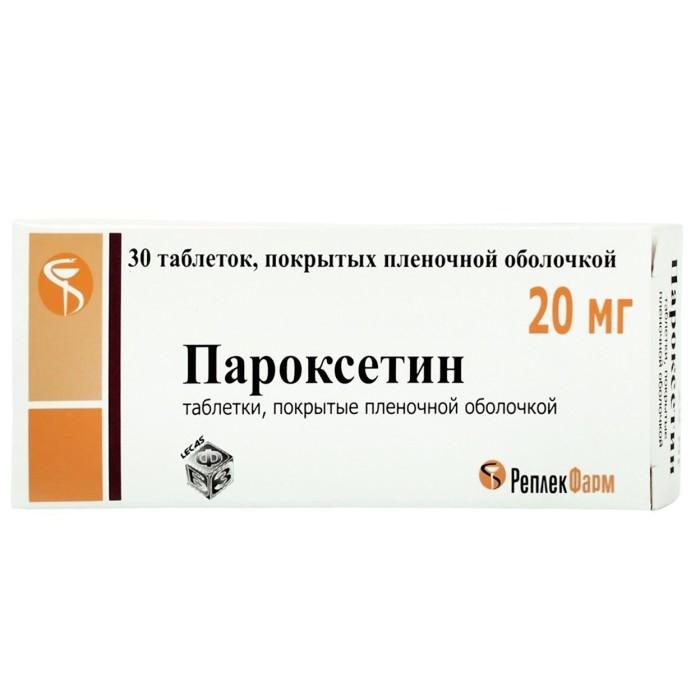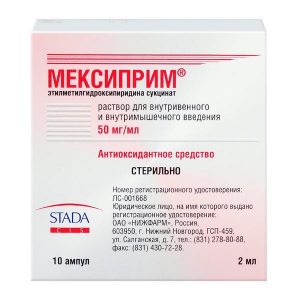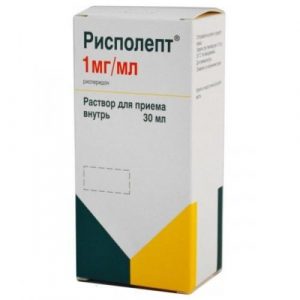Description
Release form
tablets
Pharmacological action
Paroxetine is an antidepressant. It is a selective inhibitor of serotonin (5-hydroxytryptamine, 5-HT) reuptake by brain neurons, which determines its antidepressant effect and effectiveness in the treatment of obsessive-compulsive (OCD) and panic disorder.
Paroxetine has a low affinity for m-cholinergic receptors (has a weak anticholinergic effect), 1-, 2- and -adrenoreceptors, as well as dopamine (D2), 5HT1-like, 5HT2-like and histamine H1 receptors. Paroxetine does not violate psychomotor functions and does not potentiate the inhibitory effect of ethanol on them.
According to a study of behavior and EEG in paroxetine, weak activating properties are detected when it is prescribed in doses higher than those necessary to inhibit serotonin uptake. Does not cause a significant change in blood pressure, heart rate and EEG.
Pharmacokinetics
Absorption
After oral administration, paroxetine is well absorbed from the gastrointestinal tract and is metabolized by the first passage through the liver.
Distribution of
Css is achieved 7-14 days after initiation of therapy. With an increase in dose and / or duration of treatment, a non-linear dependence of the pharmacokinetic parameters on the dose is observed.
Paroxetine is extensively distributed in tissues, only 1% of it is present in plasma.
Binds to proteins by 95%.
Metabolism
Metabolized in the liver to form inactive metabolites. It is an inhibitor of the CYP2D6 isoenzyme.
The main metabolites of paroxetine are polar and conjugated oxidation and methylation products that are rapidly excreted from the body, have weak pharmacological activity and do not affect its therapeutic effect. When paroxetine is metabolized, the selective uptake of serotonin by neurons due to its action is not disturbed.
Excretion
About 64% of paroxetine is excreted in the urine (2% – unchanged, 64% – as metabolites), approximately 36% excreted in the bile through the intestines, mainly in the form of metabolites, less than 1% – unchanged.
Excretion of paroxetine metabolites is biphasic, first as a result of metabolism of the first passage through the liver, and then it is controlled by systemic elimination. T1 / 2 of paroxetine varies, but on average is 24 hours.
Pharmacokinetics in special clinical cases
The concentration of paroxetine in blood plasma increases with impaired liver and kidney function, as well as in the elderly.
Indications
Depression of various etiologies, obsessive-compulsive disorder, panic disorder, social phobias, generalized anxiety disorder, post-traumatic stress disorder.
Contraindications
Hypersensitivity, concomitant use of MAO inhibitors (and 2 weeks after their withdrawal), age up to 18 years (efficacy and safety have not been established).
Use during pregnancy and lactation
In pregnancy, administration is permissible only in case of emergency.
FDA category of action for the fetus is C.
Breastfeeding should be discontinued during treatment (paroxetine passes into breast milk at concentrations close to those in blood serum).
Special instructions
In order to avoid the development of malignant antipsychotic syndrome, Paroxetine should be prescribed with caution to patients taking antipsychotics.
Paroxetine treatment is prescribed 2 weeks after discontinuation of MAO inhibitors.
In elderly patients with Paroxetine, hyponatremia is possible.
In some cases, dose adjustment of the simultaneously used insulin and / or oral hypoglycemic drugs is required.
With the development of seizures, treatment with Paroxetine is discontinued.
At the first sign of mania, Paroxetine therapy should be discontinued.
During the first few weeks of Paroxetine therapy, the patient’s condition should be carefully monitored in connection with possible suicidal attempts.
During therapy with Paroxetine, one should refrain from drinking alcohol in connection with an increase in its toxic effect.
Pediatric use
The use of Paroxetine in children is not recommended because its safety and effectiveness have not been established in this group of patients.
Impact on driving ability and driving mechanisms
Although paroxetine does not impair cognitive and psychomotor function, patients should abstain or exercise extreme caution when driving and engaging in other potentially dangerous activities, requiring increased concentration of attention and speed of psychomotor reactions.
Dosage and administration
Tablets should be taken orally, 1 time per day, in the morning, with meals, swallowed whole, washed down with water.
Dose is selected individually during the first 2-3 weeks after the start of therapy and subsequently adjusted if necessary.
For depression, the recommended dose is 20 mg once daily. If necessary, the dose is gradually increased by 10 mg / day, the maximum daily dose should not exceed 50 mg.
In the case of compulsive disorder, the initial therapeutic dose is 20 mg / day, followed by a weekly increase of 10 mg. The recommended average therapeutic dose is 40 mg / day, if necessary, the dose can be increased to 60 mg / day.
In panic disorders, the initial dose is 10 mg / day (to reduce the possible risk of developing exacerbation of panic symptoms), followed by a weekly increase of 10 mg. The average therapeutic dose is 40 mg / day. The maximum dose is 50 mg / day.
In case of social anxiety disorders / social phobia, the initial dose is 20 mg / day, if there is no effect for at least 2 weeks, it is possible to increase the dose to a maximum of 50 mg / day. The dose should be increased by 10 mg at intervals of at least a week in accordance with the clinical effect.
In generalized anxiety disorders, the initial and therapeutic doses are 20 mg / day.
For renal and / or liver failure, the recommended dose is 20 mg / day.
For elderly patients, the daily dose should not exceed 40 mg.
In order to prevent the development of withdrawal syndrome, discontinuation of the drug should be carried out gradually.
Side effects of
From the nervous system and sensory organs: dizziness, headache, migraine, drowsiness, insomnia, irritability, nervousness, anxiety, irritability, emotional lability, asthenia, neurosis, impaired concentration, thinking, aggressiveness, hostility tremors, convulsions, extrapyramidal disorders, hallucinations, euphoria, mania or hypomania, confusion, agitation, depersonalization, amnesia, panic attacks, paresthesia, serotonin syndrome, visual impairment, taste change.
From the musculoskeletal system: arthralgia, myalgia, myopathy, myasthenia gravis.
From the genitourinary system: impaired sexual function, including ejaculation disorders, decreased libido, anorgasmia, urinary retention, or increased urination.
From the digestive tract: decreased / increased appetite, nausea, vomiting, dry mouth, constipation / diarrhea in very rare cases – hepatitis.
From the cardiovascular system: increase or decrease in blood pressure, orthostatic hypotension, sensation of palpitations.
Allergic reactions: rash, urticaria, ecchymosis, pruritus, angioedema.
Other: myalgia, rhinorrhea, increased sweating, hyponatremia, impaired secretion of ADH, hyperprolactinemia / galactorrhea, weight loss / increase, withdrawal syndrome (with a sharp withdrawal of paroxetine).
Drug Interactions
Concomitant use of antacids does not affect the absorption and pharmacokinetic parameters of Paroxetine.
Concomitant use of Paroxetine with MAO inhibitors is contraindicated.
Concomitant administration with Paroxetine increases the concentration of procyclidine.
Due to the inhibition of cytochrome P450 by paroxetine, the effect of barbiturates, phenytoin, indirect anticoagulants, tricyclic antidepressants, phenothiazine antipsychotics and class 1C antiarrhythmics may be enhanced, metoprolol and an increased risk of side effects while prescribing these drugs.
When concomitantly prescribed with drugs that inhibit liver enzymes, a reduction in the dose of Paroxetine may be required.
Paroxetine increases bleeding time with simultaneous administration of warfarin (with unchanged prothrombin time).
With the simultaneous administration of Paroxetine with atypical antipsychotics, tricyclic antidepressants, drugs of the phenothiazine series, NSAIDs (including acetylsalicylic acid), the blood coagulation process may be disturbed.
The simultaneous administration of Paroxetine with serotonergic drugs (tramadol, sumatriptan) can lead to an increase in serotonergic effect.
Mutually enhanced effects of tryptophan, lithium and paroxetine.
With the simultaneous administration of Paroxetine with phenytoin and other anticonvulsants, an increase in the frequency of side effects is possible.
Paroxetine suppresses the antihypertensive effects of guanethidine much less than antidepressants that inhibit norepinephrine uptake.
Overdose
Symptoms: nausea, vomiting, tremor, mydriasis, dry mouth, irritability, nystagmus, agitation, sweating, drowsiness, sinus tachycardia, convulsions, bradycardia, increased BP, nodal rhythm. In very rare cases, at the simultaneous reception with other psychotropic agents and / or alcohol changes on an ECG, a coma are possible. In severe overdose – serotonin syndrome, rarely – rhabdomyolysis.
Treatment: gastric lavage, activated charcoal intake. If necessary, conduct symptomatic therapy. There is no specific antidote.
Storage Conditions
In a dry, dark place at a temperature not exceeding 25 ° C.
Expiration date
3 years
Deystvuyushtee substance
Paroxetine
Terms of drugstore
prescription
Dosage form
tablets
Possible product names NROTLPP T2LPP0.0 ¢ 0,0
PAROKSETIN TAB. PO 20MG No. 30
PAROKSETIN TAB. P / O CAPTURE. 20MG No. 30
Paroxetine tablets 20 mg, 30 pcs.
Replek Farm, Macedonia




